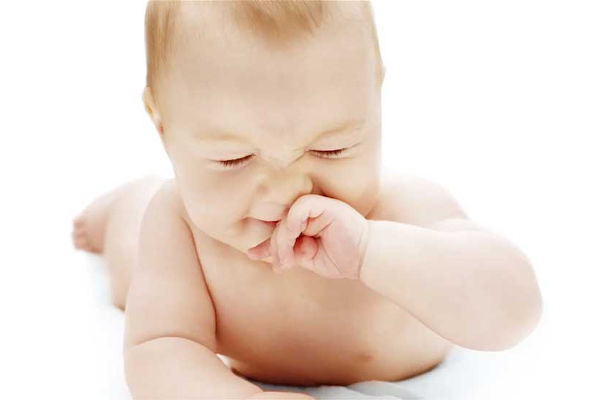Treatment of a runny nose in a 4 month old baby
Runny nose - inflammation of the mucous membrane of the nasal cavity. And if for adults rhinitis is an unpleasant, but not a serious problem, then for infants this disease can disrupt the functionality of the whole organism.
The appearance of a runny nose in a 4-month-old child is associated with a viral or bacterial lesion, which provokes the development of the inflammatory process. Babies are prone to frequent infectious diseases of the respiratory tract. This phenomenon is due to the anatomical and physiological features of the structure of the nasal cavity and reduced production of protective mucus in the first months of life. In view of weak local immunity, inflammation spreads to the pharyngeal mucosa. Therefore, if a runny nose occurs, the child needs a medical examination. Treatment is prescribed only after establishing the causes of the symptom.
The trigger mechanism in the development of the common cold are viruses. Cold air, exposure to allergens of animal, vegetable and chemical origin can also provoke an increase in the secretory function of the nasal mucosa in a child in the fourth month of life.
Protective function
The formation of mucous secretion is a mechanism for cleansing the body. Mucus secretion eliminates pathogens, irritants and organic debris. However, if the production of nasal secretion is increased, then this is a reason to consult a doctor who will determine if there is a reason for concern.

Viruses
A runny nose in a baby is infectious or non-infectious in nature (the presence of a foreign body in the nasal cavity, which provokes an increase in the formation of mucus). But infections play a dominant role. More often, a runny nose in a 4-month-old baby is associated with acute respiratory viral diseases.
Together with the air, pathogens penetrate the mucous membrane, where they settle and develop for three days. The ciliated epithelium consists of many cilia that oscillate and clear the nasal cavity of foreign agents.
bacteria
With an infectious lesion, the integrity of the respiratory mucosa is violated. An environment is created for the reproduction of pathogens. Bacterial flora joins, inflammation develops.
More often, rhinitis in children occurs during the off-season - air temperature changes affect, at which microbes are capable of infection.
Other causes of a runny nose:
- the presence of a foreign body in the nasal cavity,
- mechanical damage to the mucosa,
- negative environmental impact,
- allergic reaction.
Treatment
An acute runny nose in a child of 4 months does not require intensive therapy if there is no deterioration in well-being.
Ventilate the room, observe the temperature and humidity conditions, systematically do wet cleaning.
If a runny nose is accompanied by fever and a number of characteristic symptoms, treatment is based on the use of drugs:
- antiseptics;
- antiviral agents;
- moisturizing mucous membranes;
- vasoconstrictor drops.

Moisturizers
These funds are prescribed to moisturize the mucosa, thin the thick secretions. For this purpose, drops from sterile sea waters, saline solution cope. Such drugs are harmless, they can safely treat children in the first months of life. Washing the nasal passages is recommended to be done every two hours, 2-4 drops in each nasal passage, and before using other nasal drops to cleanse the nasal cavity.
Vasoconstrictor
Treatment of a runny nose in infants will include the use of nasal remedies that constrict the vessels of the nose. The drugs relieve local symptoms, facilitate nasal breathing, reduce the amount of mucous discharge. Rhinitis should be treated with such means with caution, following the recommendations specified in the instructions.
It is advisable to use vasoconstrictor drops without medical supervision for no more than three days, as they are addictive and thin the mucous membrane.
Therefore, it is better to use them only when absolutely necessary.
Antiviral
Antiseptics
Treatment with such agents is often prescribed in the presence of purulent exudate. Antiseptic drugs kill germs, dry the mucous membrane. Popular Protargol, which includes silver ions. You can buy it only in specialized pharmacies that make medicines themselves, or in a hospital.
Antiseptic drugs are not as harmful as vasoconstrictor drops, but can cause mucosal burns. Therefore, use them only in consultation with your doctor.
Folk methods
In addition to drug treatment, a runny nose in a baby can be treated with home methods:
- Instillation of carrot juice into the nose. The tool in a short time will help cure a runny nose in a child. Grate the carrots and squeeze the juice through a sterile gauze. It is recommended to do the procedure 3 times a day, instilling 1 drop into the nose in each nostril.
- The saline solution also helps with a runny nose. 1 tsp is added to a glass of boiled water. sea or table salt. Every 3 hours, instill 2-3 drops of the solution into the nostrils.
- Aloe helps to cure snot in babies. Place the cut leaves of the plant in the refrigerator for a couple of days. Then squeeze the juice and dilute with boiled water 1:1. The resulting product is instilled into the nose 2-3 drops three times a day.
It is important to treat a runny nose in a 4-month-old child in time, because, unlike adults, the baby suffers from the disease more difficult. If untreated, an unpleasant symptom becomes the cause of the development of unwanted complications.
